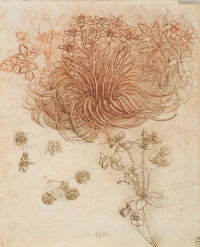The Natural World Click on the thumbnails to explore the trail
Read more about this trail (expand)
Leonardo’s endless curiosity regarding the form and function of all natural phenomena is attested to in his drawings, manuscripts and paintings. As nature could only be understood by direct “experience” or engagement with real life models, man, plants, animals, and the world that they inhabited became the subject of intense scrutiny in the quest for understanding of all natural things.

- Enlarge
- Zoom & explore
- The Royal Collection © 2005, Her Majesty Queen Elizabeth II
Study of the Star of Bethlehem c1506
Leonardo’s studies of plants indicate that his knowledge of botanical structures far outweighed the leading authorities on the subject at the time.
The main study on this sheet is a Star of Bethlehem. The careful detail with which the plant has been recorded demonstrates Leonardo’s reverence for the complexity and perfection of its forms. The leaves convey a dynamic sense of the spiralling movement that fascinated Leonardo, as attested to in many other drawings. The other plants are thought to be a crowfoot, seen to the left of the star, a wood anemone to the right, and below, the flowers and seed-pods of a euphorbia.
The drawing, which is one of Leonardo’s most beautiful nature studies, is connected to the lush vegetation in the foreground of the lost Leda and the Swan. While only a selection of the flower and plant species that may have been included in Leonardo’s painting are included in copies, the Star of Bethlehem appears in the foreground of every version. Perhaps because it is a perfect expression of the theme of Leda – the beauty of nature and its procreative powers.
In Leonardo's words
People who are little reliant upon nature are dressed in borrowed clothes, without which I would rank them with the herds of beasts
Several varieties of plants are represented in this drawing, the main study being of a Star of Bethlehem. The careful detail with which the elements of this plant have been recorded demonstrates Leonardo’s reverence for the complexity and perfection of its natural forms.
The leaves convey the dynamic sense of spiralling movement that fascinated Leonardo, as attested to in many drawings by the artist, conveying as it does the motion of natural processes inherent in natural forms.
The identity of the other plants in the drawing is unclear, but they are likely to be a crowfoot to the left of the star, a wood anemone to the right, and below, the flowers and seed-pods of a Euphorbia.
The drawing, which is one of Leonardo’s most beautiful nature studies, is connected to the lush vegetation in the foreground of the lost Leda and the Swan, which is known only through copies and preparatory drawings.
- Medium Red chalk, reworked with pen and ink
- Size 19.6 x 15.8 cm
- Location The Royal Collection










